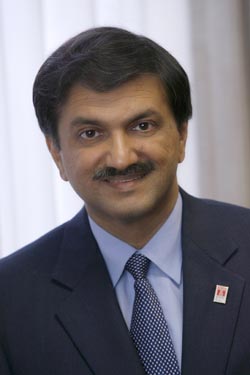Lower pay for female execs reflects bias, says Temple researcher
 Photo courtesy Rajiv Banker
Banker
|
Recently, major media outlets such as MSNBC and BBC News have been covering the pay gap between genders on a weekly basis. However, the studies available have been limited to examining only low-level workers and mid-level managers. By focusing on senior executives’ pay differences, Temple researcher and professor Rajiv Banker is breaking new ground — and finding unexplored biases at work. This month, Banker, who is the Fox School of Business’ Merves Chair in Accounting and Information Technology, completed a landmark study on the controversial topic of gender pay among top-level executives. He presented his findings during the first week of August at both the Academy of Management and American Accounting Association conferences. Although his choice of study — female executives — is unique, Banker considered his focus a natural progression from the topics that fascinate him the most. |
|
“I am interested in whether executives are paid too much or too little, and what impact their compensation has on the value they create for the corporation. I am also interested in organizational practices that enable companies to develop and retain talented people from non-traditional segments of the population, such as women and underrepresented minorities,” he said. Along with his passion for the subject, Banker brings years of experience to his research. For more than 20 years, he has researched executive compensation, and for the past three years, he has studied the gender pay gap of executives. To conduct his current research, Banker compared the compensation of males and females who serve as one of the top five executives in major North American corporations. His latest paper, co-authored with Mark Anderson at the University of Texas and Rong Huang at the City University of New York, reports that female executives are on average paid 19 percent less than their male counterparts. This discovery is congruent with previous research on the difference in pay between males and females for low- and mid-level workers. “There are two major theories as to why women are paid less,” Banker explained. “The human capital theory says that people are paid for the value they create for the organization, and that women create less. One reason for this might be that women are excluded from social networks that help bring in more customers,” Banker said. “The other explanation is the social bias theory, which states that people who are underrepresented are more likely to be underpaid.” To uncover which one of these theories was at work for top-level executives, Banker developed a statistical model that compared individuals’ compensation with the value they created for the company. He discovered that female executives are adding significantly greater value to shareholders per dollar of pay than their male counterparts. This contradicts the human capital theory, pointing instead to social bias as the cause of the salary discrepancy. Even at the executive level, women are unfairly underpaid. Banker analyzed the data of different industries and found that “women are underpaid more in industries in which they are underrepresented, such as utilities, oil and gas, and coal extraction.” he said. When more women are represented in senior executive ranks in an industry, female executives are more likely to be paid for the value they create. These findings are also consistent with the social bias theory. Given the weight of his findings, Banker says he hopes that his research will help people realize that these biases exist and that they might be driving how companies evaluate and reward people. His research also will help companies look for ways to make the best use of available talent. This work, titled “The Gender Pay Gap in the Board Room: Are Women Executives Underpaid?” is one of many studies Banker has conducted. A prolific researcher, he has published more than 150 articles in prestigious research journals including Management Science, Academy of Management Journal, Accounting Review, Journal of Accounting and Economics and Journal of Accounting Research. One of his papers that developed a new method for comparative performance evaluation is ranked fourth-highest in citations in the 50-year history of Management Science. Already, he has begun to work on another research project. His new research will analyze how professional service firms develop and retain talent among underrepresented populations. — Written by Holly Otterbein for the |
|